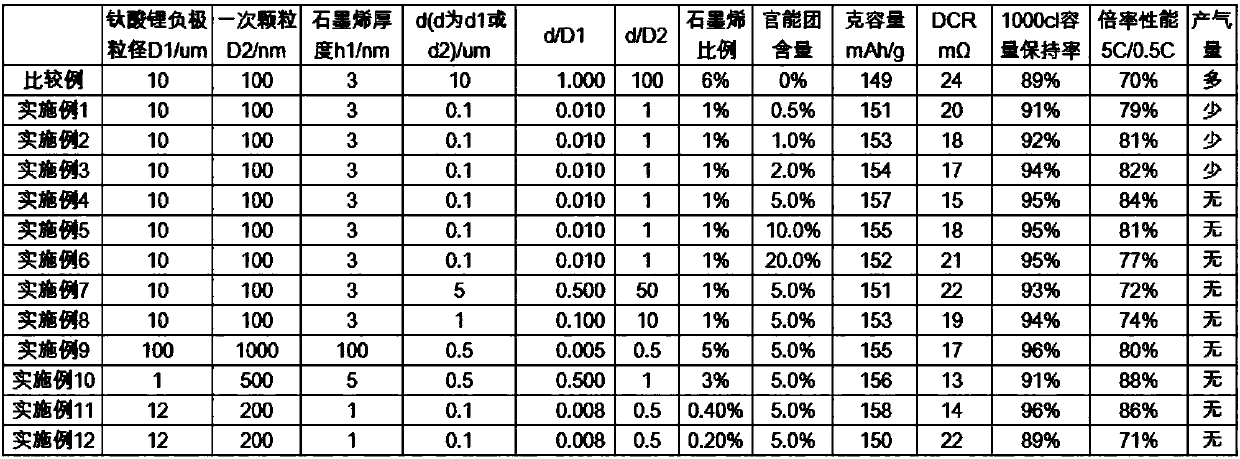Lithium titanate negative electrode material and preparation method thereof
A negative electrode material, lithium titanate technology, applied in the direction of negative electrode, battery electrode, active material electrode, etc., can solve the problem of hindering the intercalation of lithium ions and lithium titanate materials, the weak force of graphene sheets, and the easy gas production of batteries and other problems, to achieve excellent processing and cycle performance, excellent structural stability, and reduce the effect of hindrance
- Summary
- Abstract
- Description
- Claims
- Application Information
AI Technical Summary
Problems solved by technology
Method used
Image
Examples
Embodiment 1
[0035] Embodiment 1 differs from Comparative Example 1 in that the present embodiment comprises the following steps:
[0036] Step 1, select the lithium titanate particle that particle diameter is 100nm, the functionalized graphene sheet layer that sheet thickness is 3nm, sheet plane diameter is 0.1 μ m is electronic conduction component (the lithium titanate particle and graphene between The mass ratio is 99:1); the functional group (including hydroxyl, carboxyl and carbonyl) content is 0.5% of the mass of the entire electron-conducting component, and the precursor is obtained after being uniformly mixed with the solvent;
[0037] Step 2, through the hydrothermal reaction, the graphene molecules of the electron-conducting components containing functional groups are cross-linked to form a strong bonding force to complete the construction of the conductive network, and at the same time fix the primary particles in the network structure; Through mechanical shearing (stirring), a...
Embodiment 2
[0040] Embodiment 2 is different from Embodiment 1 in that this embodiment includes the following steps:
[0041] Step 1, select the lithium titanate particle that particle diameter is 100nm, the functionalized graphene sheet layer that sheet thickness is 3nm, sheet plane diameter is 0.1 μ m is electronic conduction component (the lithium titanate particle and graphene between The mass ratio is 99:1); the functional group (including hydroxyl, carboxyl and carbonyl) content is 1% of the mass of the entire electron-conducting component, and the precursor is obtained after being uniformly mixed with the solvent;
[0042] Others are the same as in Example 1, and will not be repeated here.
Embodiment 3
[0043] Embodiment 3 is different from Embodiment 1 in that this embodiment includes the following steps:
[0044] Step 1, select the lithium titanate particle that particle diameter is 100nm, the functionalized graphene sheet layer that sheet thickness is 3nm, sheet plane diameter is 0.1 μ m is electronic conduction component (the lithium titanate particle and graphene between The mass ratio is 99:1); the functional group (including hydroxyl, carboxyl and carbonyl) content is 2% of the mass of the entire electron-conducting component, and the precursor is obtained after being uniformly mixed with the solvent;
[0045] Others are the same as in Example 1, and will not be repeated here.
PUM
| Property | Measurement | Unit |
|---|---|---|
| diameter | aaaaa | aaaaa |
| thickness | aaaaa | aaaaa |
| diameter | aaaaa | aaaaa |
Abstract
Description
Claims
Application Information
 Login to View More
Login to View More - R&D Engineer
- R&D Manager
- IP Professional
- Industry Leading Data Capabilities
- Powerful AI technology
- Patent DNA Extraction
Browse by: Latest US Patents, China's latest patents, Technical Efficacy Thesaurus, Application Domain, Technology Topic, Popular Technical Reports.
© 2024 PatSnap. All rights reserved.Legal|Privacy policy|Modern Slavery Act Transparency Statement|Sitemap|About US| Contact US: help@patsnap.com








